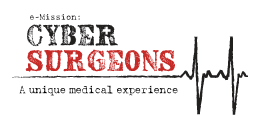The Integumentary System
Student Pages
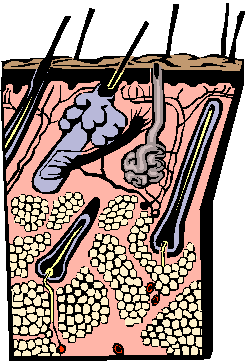
Structure and Function
The skin is the largest organ of the body and is composed of two layers—the epidermis (outer layer) and the dermis (inner layer). The epidermis is a thin layer of cells and forms a protective layer over the inner dermis. It prevents excessive water loss and prevents disease-causing microorganisms from entering the skin. Melanocytes (cells in the skin) contain melanin which absorbs light energy and helps protect against the damaging effects of ultraviolet rays from the sun. Melanin gives the skin color.
New skin cells are made at the bottom of the epidermis and as older cells are sloughed off, new cells rise to take their places.
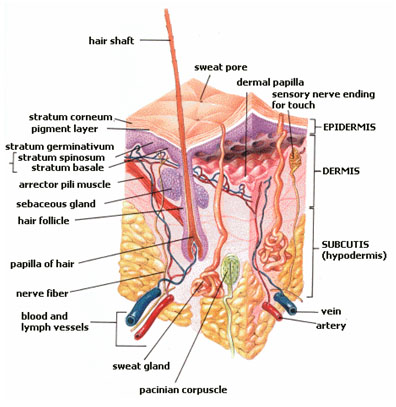 The dermis is a much thicker layer that contains connective tissue, smooth muscle tissue, nerve tissue, and blood. This layer contains the subcutaneous layer of fat tissue which helps retain heat. Several other structures are found in this layer. These include hair follicles, sebaceous glands (secrete oils that keep hair and skin soft and relatively waterproof), and sweat glands
The dermis is a much thicker layer that contains connective tissue, smooth muscle tissue, nerve tissue, and blood. This layer contains the subcutaneous layer of fat tissue which helps retain heat. Several other structures are found in this layer. These include hair follicles, sebaceous glands (secrete oils that keep hair and skin soft and relatively waterproof), and sweat glands
(excretes wastes, evaporates water and heat). Nails originate from this layer. Nerve cells in the dermis receive stimuli from the environment and sense pain, temperature, and pressure.
The skin is not merely a covering for the body. It has vital functions that allow humans to maintain a constant body temperature, retain moisture in a dry world, keep out bacteria and other pathogens, and heal injuries to the layers.
Maintaining a constant body temperature
When your body heats up from exercise or from increased environmental temperatures, blood vessels in the skin dilate, blood flow increases, and heat is lost through radiation. When your internal temperatures are too cool, blood vessels in the skin constrict, blood flow decreases, and heat is conserved. Glands in the dermis produce sweat if the body overheats. As the sweat evaporates, the body cools. These are major ways that humans maintain a constant, warm-blooded body temperature. (Cold-blooded animals do not maintain a constant body temperature and are, basically, the temperature of the environment. That’s why reptiles in the desert find shade during the day and burrow under leaves during northern winters—snakes don’t sweat.
Healing
A critical function of skin is to aid in healing wounds. Wounds become inflamed when blood vessels in the wounded tissue release blood and fluid. The fluids may make the tissues swell, but they also deliver nutrients that help the healing process.
When a wound occurs that involves the deeper tissues, the blood clots and a scab forms. Cells migrate into the injured region and form new fibers that bind the edges of the wound together. White blood cells engulf bacteria that may have entered the region. After the damaged tissues are replaced, the scab falls off. If the wound is extensive, the newly formed tissues may form a scar on the skin surface.
Skin Cancer
Skin cancer is the most common type of cancer in the United States. It can occur at any age, but it used to occur primarily in people over age 50. Approximately 40-50 % of Americans who live to the age of 65 will have skin cancer at least once. In recent years, there has been a steadily decreasing age at which skin cancer occurs. This is most likely due to the increase in tanning salons and the practice of tanning the skin year-round. There are reports now of melanomas (skin cancers) in young people in their early 20’s. At increased risk are those people with fair skin, with red or blond hair, or with blue or light-colored eyes.
Exposure to the damaging ultraviolet (UV) rays of the sun is the main cause of skin cancer. Two types of UV rays, UVA and UVB rays, cause lasting damage to the skin layers. Artificial sources of ultraviolet rays, such as sunlamps or tanning booths can also cause skin cancer.
Skin cancer is also related to lifetime exposures to UV radiation. Therefore, it is important to protect yourself early in life and to continue those protective habits in order to prevent skin cancer later.
How do you protect yourself? How do you avoid developing skin cancer?
Wear protective clothing if you are going to be outside for long periods of time or if you are outside during the peak midday sun hours. Use suncreen or sunblock lotions with a sun protection factor (SPF) that fits your location, time, and activity.
How to recognize skin cancer symptoms
Not all skin cancers look the same, but they all involve some change in the skin, such as a change in an old growth, a sore that doesn’t heal, or the appearance of a new growth. Not all growths will be cancerous, but it is important to get them checked early. The cure rate for skin cancers could be 100% if they were detected early enough for effective treatment. Don’t wait for pain before getting the growth checked—few skin cancers are painful.
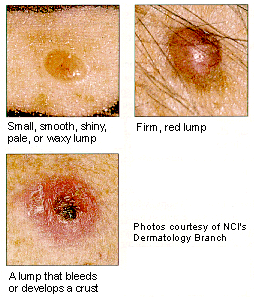
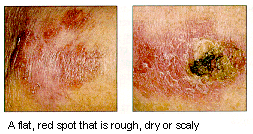
The American Academy of Dermatology has created an easy way to help recognize the signs of skin cancer. Remember the ABCD’s!
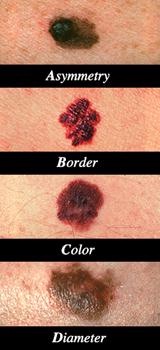
Asymmetry—The growth is not symmetrical; one half does not match the other half.
Border—The border of a melanoma is irregular. Normal growths have regular borders.
Color—The color of a melanoma is uneven, having several colors throughout the same growth. It can also be intensely black with possibly a bluish tint.
Diameter—If the growth is larger than approximately a quarter of an inch, it may be malignant.
Checking for Understanding
- What are the functions of the integumentary system?
- Why do burn victims often require skin grafts?
- Why are burn victims in reverse isolation in the hospital? (Isolation is separating a patient from other patients in order to prevent the spread of a contagious disease. Reverse isolation is separating a patient from other patients so he/she will get come into contact with disease-causing organisms.)
- What are the ABCD’s of skin cancer?
A—
B—
C—
D—
